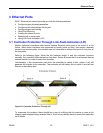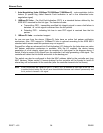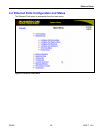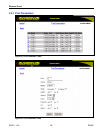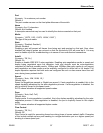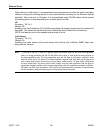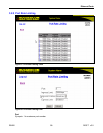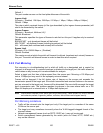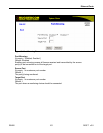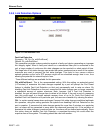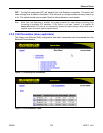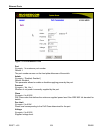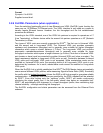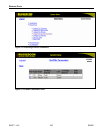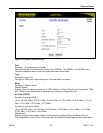
Ethernet Ports
ROS™ v3.5 100 RS400
Default: 1
The port number as seen on the front plate silkscreen of the switch.
Ingress Limit
Synopsis: { Disabled, 128 Kbps, 256 Kbps, 512 Kbps, 1 Mbps, 2 Mbps, 4 Mbps, 8 Mbps }
Default: 1 Mbps
The rate at which received frames (of the type described by the ingress frames parameter) will
start to be discarded by the switch.
Ingress Frames
Synopsis: { Broadcast, Multicast, All }
Default: Broadcast
This parameter specifies the types of frames to rate-limit on this port. It applies only to received
frames:
BROADCAST - only broadcast frames will be limited
MULTICAST - all multicast frames (including broadcast) will be limited
ALL - all frames (both multicast and unicast) will be limited
Egress Limit
Synopsis: 62 to 256000 Kbps or { Disabled }
Default: Disabled
The maximum rate at which the switch will transmit (multicast, broadcast and unicast) frames on
this port. The switch will discard frames in order to meet this rate if required.
3.2.3 Port Mirroring
Port mirroring is a troubleshooting tool in which all traffic on a designated port is copied (or
mirrored) to a target port. If a protocol analyzer is attached to the target port, the traffic stream of
valid frames on any source port is made available for analysis.
Select a target port that has a higher speed than the source port. Mirroring a 100 Mbps port
onto a 10 Mbps port may result in an improperly mirrored stream.
Frames will be dropped if the full duplex rate of frames on the source port exceeds the
transmission speed of the target port. Since both transmitted and received frames on the source
port are mirrored to the target port, frames will be discarded if the sum traffic exceeds the target
port’s transmission rate. This problem reaches its extreme in the case where traffic on a 100
Mbps full duplex port is mirrored onto a 10 Mbps half duplex port.
Note: Invalid frames received on the source port will not be mirrored. These include CRC errors, oversize
and undersize packets, fragments, jabbers, collisions, late collisions and dropped events).
Port Mirroring Limitations
• Traffic will be mirrored onto the target port only if the target port is a member of the same
VLANs as the source port.
• The target port may sometimes incorrectly show the VLAN tagged/untagged format of the
mirrored frames.
• Network management frames (such as RSTP, GVRP etc. ) may not be mirrored.
• Switch management frames generated by the switch (such as Telnet, HTTP, SNMP etc.)
may not be mirrored.




